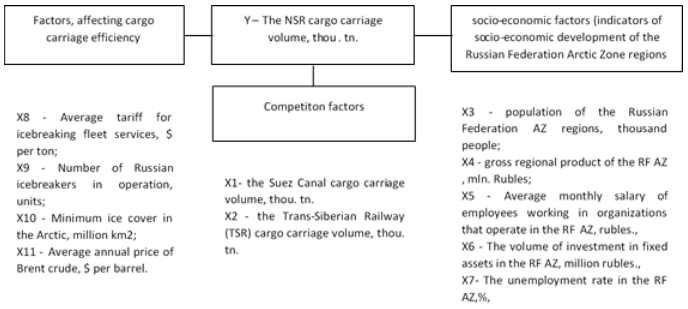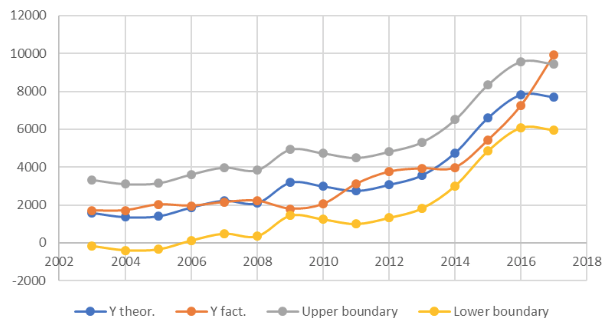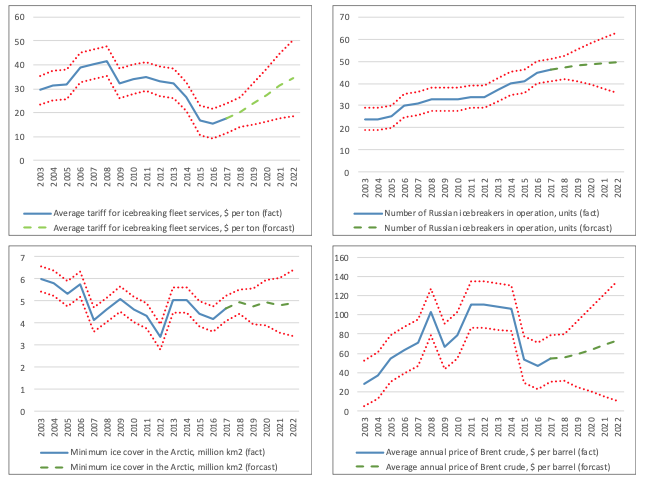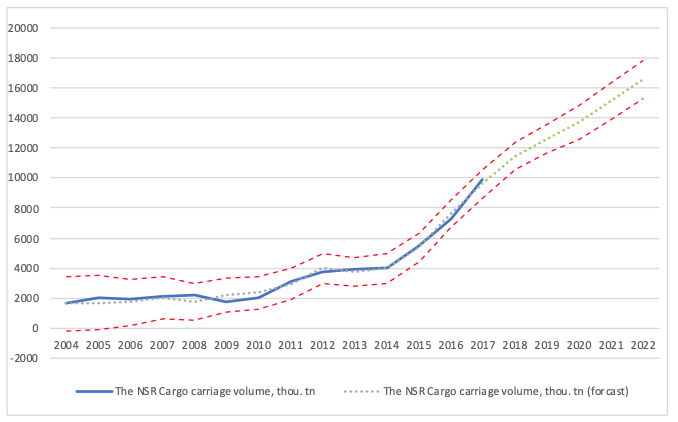

Vol. 40 (Number 25) Year 2019. Page 20
GUTMAN, Svetlana 1; KONNIKOV, Evgenii 2 & KUZNETSOV, Roman 3
Received: 08/04/2019 • Approved: 11/07/2019 • Published 22/07/2019
ABSTRACT: The article describes the possible ways of the Northern Sea Route (NSR) development and lays out the main factors affecting the NSR cargo carriage volume. The purpose of the study is to identify how the NSR cargo carriage volume depends on endogenous and exogenous factors and to elaborate recommendations for further development of the NSR. A conceptual model based on endogenous and exogenous variables was built within the framework of the study. The variables for the model were chosen as follows: an endogenous variable Y - the NSR cargo carriage volume (in thousand of tons); and groups of exogenous variables: 1) competition factors, 2) socio-economic factors, including: indicators of socio-economic development of the Russian Federation Arctic Zone regions (RFAZ) and 3) factors affecting cargo carriage efficiency. In Competition factors it was include: Suez Canal cargo carriage volume stimated in thousand tonnels (ton.) and the Trans-Siberian Railway (TSR) cargo carriage volume. The Socio-economic factors include: population of the RFAZ stimated in thousand people; gross regional product of the RFAZ, (million Rubles); the average monthly salary of employees working in organizations that operate in the RFAZ expressed in Rubles and the volume of investment in fixed assets in the RFAZ, also stimated in million rubles and the percentage rate of unemployment in the RFAZ. The Factors affecting cargo carriage efficiency include average tariff for icebreaking fleet services calculated in Dollars ($) per ton; number of Russian icebreakers in units of operation; the minimum ice cover in the Arctic stimated in million of square Kilometers (km2) and the average annual price of Brent crude in $ per barrel. The analysis conducted showed that the factors from the last group -factors affecting the efficiency of cargo transportation- are the most influential factors. Within these factors, the most important are: the average tariff for icebreaker fleet services stimated in $/ton., the number of units of Russian icebreakers in operation, and finally the minimum ice cover in the Arctic in million/km2. |
RESUMEN: El artículo describe las posibles formas de desarrollo de la Ruta del Mar del Norte (NSR) y presenta los principales factores que afectan el volumen del transporte de carga de la NSR. El propósito del estudio es identificar cómo el volumen de transporte de carga de la NSR depende de factores endógenos y exógenos y elaborar recomendaciones para un mayor desarrollo de la NSR. Un modelo conceptual basado en variables endógenas y exógenas se construyó dentro del marco del estudio. Las variables para el modelo se eligieron de la siguiente manera: una variable endógena Y: el volumen de transporte de carga NSR (en miles de toneladas); y grupos de variables exógenas: 1) factores de competencia, 2) factores socioeconómicos, que incluyen: indicadores del desarrollo socioeconómico de las regiones de la Zona Ártica de la Federación de Rusia (RFAZ) y 3) factores que afectan la eficiencia del transporte de carga. En los factores de competencia se incluyeron: el volumen del transporte de carga del Canal de Suez estimado en miles de toneladas (tonelada) y el volumen del transporte de carga del Ferrocarril Transiberiano (TSR). Los factores socioeconómicos incluyen: población estimada de RFAZ en miles de personas; producto regional bruto de la RFAZ, (millones de rublos); el salario promedio mensual de los empleados que trabajan en organizaciones que operan en el RFAZ expresado en rublos y el volumen de inversión en activos fijos en el RFAZ, también se estimó en millones de rublos y el porcentaje de desempleo en el RFAZ. Los factores que afectan la eficiencia del transporte de carga incluyen una tarifa promedio para los servicios de la flota de rompehielos calculados en dólares ($) por tonelada; número de rompehielos rusos en unidades de operación; la cobertura mínima de hielo en el Ártico estimada en millones de kilómetros cuadrados (km2) y el precio promedio anual del crudo Brent en $ por barril. El análisis realizado mostró que los factores del último grupo (factores que afectan la eficiencia del transporte de carga) son los factores más influyentes. Dentro de estos factores, los más importantes son: la tarifa promedio para los servicios de la flota de rompehielos estimada en $ / tonelada, el número de unidades de rompehielos rusos en operación y, finalmente, la cobertura mínima de hielo en el Ártico en millones / km2. |
The Northern Sea Route (NSR) was opened for international shipping in 1991. During Soviet times, the northern waters were used exclusively for domestic needs. Today, the NSR is a strategic maritime transport route, which plays an important role in development of both the Russian economy and the world. This waterway for international trade ensures the security of the state and allows developing the entire Arctic region. The NSR is the shortest way from Europe to the Asia-Pacific region, but by far not the solitary one, which is why the maximum return on its use depends on the ability to compete with alternative routes. A systematic approach to the development of the Arctic region and the formation of competitive advantages requires modifying the development of the transport system, summarizing possible options for the international legal regulation of marine operations, national and environmental security in the Arctic. The last includes international cooperation, peculiarities concerning the legal regime of navigation along the NSR, geographical borders and the legal regime of the maritime spaces of the Russian Arctic. The main element of the Arctic transport system is maritime transport. The Arctic Maritime Transport System is represented by the following elements:
• The Northern Sea Route, which is the most important part of the economical infrastructure, connecting the European and Far Eastern parts of the country into a single transport system;
• The fleet’s vehicles of the sea and river and their motion path, represented by sea and river’s lines.
• Coastal infrastructure (ports and components navigational and hydrographic of support and various medium of communication that habitually are providing the transport activities in the RFAZ.
The Northern Sea Route operates the ports of the Arctic zone and major rivers of Siberia (including fuel imports; equipment; foodstuffs; timber export; natural resources) (Lukin, 2015). There are alternative sea routes passing through the Suez and Panama canals, but the distance between the port of Múrmansk (Russian city) and the port of Yokohama (city in Japan) through Suez is more than 2 times longer than the Northern Sea Route (Rogozin, 2016). However, for successful operation, enhancement of existing opportunities and opening up the new ones, it is necessary not only to upgrade the existing ports of the Arctic zone (Tiksi, Dudinka, Dickson, among others Arctic ports), but also to create completely new ones, such as Indiga, Murmansk, Kharasavey .
Under modern conditions, the systems of information exchange, navigation, and communications ensuring the growth of logistics efficiency, reducing the time and cost of transportation, and increasing the quality of transport services have come to the forefront of competition (Kikkas, 2015). In 2015, as a part of the research complex, the Ministry of Transport of Russia carried out a research entitled “Development of prospective areas for the use of the GLONASS system in managing multimodal transport and logistics hubs to increase the capacity of international transport corridors (ITC)” (Rogozin, 2016). According to the concept, the GLONASS system is provided for use in the transport and logistics systems of the ITC. The purpose of this research was to identify modern technical and organizational mechanisms and to develop proposals for improving the efficiency (including throughput) of the ITC passing through the territory of the Russian Federation (Boreyko, 2016).
There is a large amount of scientific reports devoted to the functioning issue of the ITC including the NSR; to the analysis of the economic factors influencing the NSR operational process in modern conditions and opportunities and threats to its activities. The analysis of scientific literature has revealed that the scientific works devoted to the analysis, elaboration and design of the NSR development, forecast that this issue can be divided into two large sets (groups). The first group of papers (Lukin, 2015; Kikkas, 2015; Skripnuk, 2016; Komkov et al., 2016; Bashmakova et al., 2015; Erokhin, 2017; Ragner, 2000; Stephenson et al., 2014) describes (considers) the influence of individual factors on development and potential of the NSR, including the influence on the freight traffic through the NSR.
In another group of scientific papers, a comparative analysis is carried out between alternative transport corridors, with a special attention paid to the NSR ability to compete with alternative routes from Europe to Asia that provide international trade between regions. The papers tha consider the potential economical feasibility of using the NSR as an alternative route between Asia and Europe, include: Liu and Kronbak, 2010; Pierre and Olivier, 2015; Plisetsky, 2016; Furuichi and Otsuka, 2013; Verny and Grigentin, 2009; Carlsson and Granholm, 2013; Kitagawa, 2009; Schøyen and Bråthen, 2011.
The purpose of this study is to identify the dependence of the NSR cargo carriage volume on endogenous and exogenous factors and to develop recommendations for the further development of the NSR.
The methods for attaining the purposes of this study include: system analysis, comparative analysis and content analysis. This analyzes to belong to the category of qualitative methods. The methodological basis of the calculations performed in the article are methods for collecting and processing statistical information, including the regression analysis, that served as a basis for designing the multiple regression model. In accordance to the literature analyzed (Lukin, 2015; Kikkas, 2015; Skripnuk, 2016; Komkov et al., 2016; Bashmakova et al., 2015; Erokhin, 2017; Ragner, 2000; Stephenson et al., 2014; Skripnuk, 2016; Komkov et al., 2016; Liu and Kronbak, 2010; Pierre and Olivier, 2015; Plisetsky, 2016; Furuichi and Otsuka, 2013; Verny and Grigentin, 2009; Carlsson and Granholm, 2013; Kitagawa, 2009; Schøyen and Bråthen, 2011; Rudskaya and Rodionov, 2017), the following exogenous and endogenous variables were selected in order to elaborate a conceptual model:
Y – The NSR Cargo carriage volume, thousand tons.
(1) A group of variables as "Competiton factors":
X1- the Suez Canal cargo carriage volume, thousand tons.
X2 - the Trans-Siberian Railway (TSR) cargo carriage volum, thousand tons.
(2) A group of variables as "socio-economic factors (indicators of socio-economic development of the RFAZ)":
X3 - population of the RFAZ, thousand people;
X4 - gross regional product of the RFAZ , million rubles;
X5 - Average monthly salary of employees working in organizations that operate in the RF AZ, rubles.
X6 - The volume of investment in fixed assets in the RFAZ, million rubles,
X7- The percentage rate of unemployment in the RF AZ,%,
(3) A group of variables as " Factors, affecting cargo carriage efficiency”:
X8 - Average tariff for icebreaking fleet services, $ per ton;
X9 - Number of Russian icebreakers in operation, units;
X10 - Minimum ice cover in the Arctic, million km2;
X11- Average annual price of Brent crude, $ per barrel.
Then, for all the variables mentioned, primary statistical data for the period from 2003 to 2017 was collected. The regression analysis of this data was a basis for a multiple regression model design. This study applies the classical regression analysis methodology proposed by Dougherty (2016). The quality assessment of the model constructed was carried out by means of the determination coefficient of Fisher's F-test. If the closer determination coefficient of is to 1, the more accurate the model is, therefore, the coefficient must be at least 0.7 (R2 ≥ 0.7). If F fact. > F teor., then the model elaborated is significant, i.e. the sample corresponds to the general population. It is also necessary to exclude the exogenous variables with the coefficients significance for the p-value ≥ 0.05. At the next stage, private elasticity coefficients were calculated. The coefficients show the way the result variable Y changes (on average) with an increase in the factor xj by 1% of its average level with other model factors fixed. Then the exogenous variable that has the greatest effect on the endogenous variable was selected (Dougherty, 2016).
Thus, in the course of this study, the analysis of the dependence of the cargo carriage volume through the NSR on the selected factors was carried out by means of a multiple regression model. Figure 1 presents a conceptual model with initial endogenous and exogenous variables.
Figure 1
Conceptual model that shows the effects of exogenous
variables on the NSR Cargo carriage volume

The primary statistics for the period from 2003 to 2017 for all the variables mentioned were obtained from official sources (SCA, 2017; Coordinating Council on Trans-Siberian Transportation, 2017; Rosstat, 2017; Portnews, 2017; Techexpert, 2017).
To build a multiple regression model, 4 regression analyzes were performed. In accordance with the first analysis results, the following variables were excluded: X1 (the Suez Canal, cargo carriage volume, thousand tons), X2 (the Trans-Siberian Railway cargo carriage volume, thousand tons), X5 (Average monthly salary of employees of organizations operating in the RFAZ, rubles) and X7 (the percentage rateof unemployment in the RFAZ,%,) since their p-value exceeded 0.05 . In accordance with the results of the second analysis, the following variables were excluded: X3 (population of the RFAZ regions, thousand people), X4 (Gross regional product of the RFAZ, million rubles.), since their p-value exceeded 0.05. In accordance with the third analysis results, the variable X6 (the volume of investment in fixed assets in the AZ of the Russian Federation, mln. rubles) was excluded, since its p-value exceeded 0.05. In accordance with the results of the last regression analysis, the coefficient of determination was obtained (R) = 0.86 (> 0.7) and F fact. = 15.00947> F theory. = 3.48, therefore, the equation in general is significant. The parameters of the equation are also significant, as their p-values are <0.05. Considering the found coefficients, the multiple regression model looks as follows (1):

The results obtained by means of the model are as follows:
In order to determine the exogenous variables that have the greatest influence on the endogenous one, elasticity coefficients were calculated, making it possible to determine the factors that have the greatest influence on the endogenous variable. The coefficients are presented in the Table 1.
Table 1
The values of Elasticity coefficients
for exogenous variables
X |
Y |
X8 - Average tariff for icebreaking fleet services, $ per ton; |
2,01921 |
X9 - Number of Russian icebreakers in operation, units; |
2,881014 |
X10 - Minimum ice cover in the Arctic, million km2; |
-1,77352 |
X11- Average annual price of Brent crude, $ per barrel. |
-0,14723 |
Further, in order to find the upper and lower boundaries of the confidence interval, theoretical values of Y were calculated (see Figure 2).
Figure 2. Graph demonstrating the dynamics of changes in the endogenous variable Y and its confidence interval.
Figure 2
Dynamics of changes in the NSR Cargo carriage volume and its
confidence interval (X variable - the analyzed period (years))

The graph above reveals that all theoretical Y values belong to the confidence interval. On the basis of the analysis we have the opportunity to build a forecast of the development of cargo turnover on the NSR. For forecasting purposes, the models of ARMA class and regARIMA class are used (Dougherty, 2016). To improve the quality of the prediction, model (1) was also improved by integrating the autoregressive component. The developed tools can be formed into the following system of equations:

We used the program IBM SPSS 23 to build this model.The coefficient of determination of the first equation materially exceeds the coefficient of determination of equation (1), and equals 0.97. The coefficient of determination of the subsequent equations ranges from 0.65 to 0.85, which is also sufficient for the purposes of this study. The results of the prediction of the relevant factors are presented in Figure 3.
Figure 3
Forecast of factors affecting the turnover of the
NSR (X variable - the analyzed period (years))

-----
Figure 4
Forecast of the turnover of the NSR to 2022

The econometric model designed made it possible to determine factors having the biggest influence on the NSR cargo carriage volume. Factors from the group “Factors affecting cargo carriage volume” that turned out to be the most influential were:
If these factors are considered exclusively as factors affecting the efficiency of cargo transportation, then their influence can be explained logically, with one exception. Without icebreakers, the passage of ships through the NSR is impossible under current legislation, and the more icebreakers there are, the more ships can take the transport route. No wonder this factor is the most significant. Ice is the main obstacle of the NSR, affecting greatly the attractiveness of the route for carriers. During the navigation period, the Arctic ice sheet retreats a little, which allows saving on icebreaker assistance. This cause an increase in the NSR cargo carriage volume. Reducing the average tariff for icebreaking fleet services naturally increases the attractiveness of the main line. Carriers are always looking for a more beneficial delivery option.
In contrast, the factor “The average annual price of Brent crude oil” -in this model- cannot be attributed to the factors affecting the efficiency of transportation. That is why this indicator should be related to other groups of factors. This relationship can be explained by the strong dependence of the Russian economy on oil prices. The fall in oil prices affects funding from the Northern Sea Route state of development, therefore, it slows down the construction of icebreakers, the port infrastructure development, the pace of improvement in life quality in the Arctic zone, etc. It is necessary to note that this factor is the most insignificant in the model.
Over the past three years there has been a boost in the cargo carriage volume through the NSR. This can be explained by the fall in the Ruble exchange rate, which resulted in a decrease in the average tariff for the icebreaker fleet services. This is because all icebreaking wiring is paid in rubles, which is very beneficial for the foreign carriers, and for all "non-ruble companies" who can use the NSR to transport goods.
Оn the basis of the elasticity coefficients, we can conclude that the increase in the average tariff for icebreaker fleet services by 1% leads to a decrease in the NSR cargo carriage volume by 2,02%; the increase in the number of Russian icebreakers by 1% leads to an increase in the NSR cargo carriage volume by 2,88%, which makes X9 the most significant factor; the increase in the minimum ice cover in the Arctic by 1% leads to a decrease in the NSR cargo carriage volume by 1,77% and the increase in the average annual price of Brent crude oil by 1% leads to a decrease in the NSR cargo carriage volume by 0,15%. The dynamics of predicted exogenous variable values is ambiguous, but the key factors that have a direct and greatest impact on the turnover of the NSR have a steady growth. Аccording to the established methodology, the turnover of the NSR has a steady and dynamic growth. The reasons for this growth are quite heterogeneous and may be the subject of a separate study
The NSR is a route with great potential, but for its sustainable development large investments are needed, since at the moment, there are more problems than advantages. According to the authors, to increase the NSR cargo carriage volume it is necessary to invest in modernization of the icebreaker, transport and ice fleet; and to develop the port infrastructure.
The article is prepared with the support of Ministry of Science and Higher Education of Russian Federation (project No. 26.6446.2017/ БЧ ).
In this section you can acknowledge any support given which is not covered by the author contribution or funding sections. This may include administrative and technical support, or donations in kind (e.g., materials used for experiments).
Rogozin, D.O. (2016), The main direction of the implementation of the state program "Socio-economic development of the Arctic zone of the Russian Federation". Scientific and informational and analytical journal “Arctic. Economy and technology”. Recovered from http://arctica-ac.ru/newstext/54/.
Lukin, Yu.F. (2015). Analysis of the Northern Sea Route Activity. Vestnik of MSTU book 18, 3(9), 467-475.
Boreyko, A.E. (2016). The use of modern navigation and information technologies to improve the efficiency of the Arctic transport complex. Arctic transport & Logistics, 19(3), 31–33.
Kikkas, K.N. (2015). International transport corridors and the Arctic. M.I.R. (Modernization. Innovation. Research) book 6, 3(7), 178–184.
Skripnuk, D.F. (2016). The Northern Sea Route in the system of international transport corridors. Arctic: history and modernity, 12, 509-520.
Komkov, N.I., Selin, V.S., Tsukerman, V.A., and Goryachevskaya, E.S. (2016). Scenario forecast of the development of the Northern Sea Route. Studies on Russian Economic Development book 27, 2(9), 180-188.
Bashmakova, E., Biev, A., Vasil’ev, V. et al. (2015). Factor analysis and forecast of cargo flows of the Northern Sea Route; Kola Science Centre: Apatity, Russia, pp. 270-281.
Erokhin, V.L. (2017). Northern Sea Route and Arctic transport corridors: problems of utilization and forecasts of cargo traffic commercialization. Marketing and Logistics, 6(23), 22-44.
Ragner, C. (2000). Northern Sea Route cargo flows and infrastructure–present state and future potential; Fridtjof Nansen Institute: Lysaker, Norway, pp. 1-10.
Stephenson, S.R., Brigham, L.W., and Smith, L.C. (2014). Marine accessibility along Russia's Northern Sea route. Polar Geography, 37(2), 111-133.
Innov: electronic journal. Problems of social and economic development of Arctic territories. Recovered from http://www.innov.ru/science/economy/problemy-sotsialno-ekonomicheskogo-/
Liu, M., and Kronbak, J. (2010). The potential economic viability of using the Northern Sea Route (NSR) as an alternative route between Asia and Europe. Journal of Transport Geography, 18(3), 434-444.
Pierre, C., and Olivier, F. (2015). Relevance of the Northern Sea Route (NSR) for bulk shipping. Transportation Research Part A: Policy and Practice, 78(10), 337-346.
Plisetsky, E.E. (2016). Priorities of the strategic management and planning of the Northern Sea Route. Arctic and North No. 22, 11, 101-111.
Furuichi, M., and Otsuka, N. (july, 2013). Cost analysis of the Northern Sea Route (NSR) and the conventional route shipping. Proceedings of IAME 2013 Conference, Marseille, France.
Verny, J., and Grigentin, C. (2009). Container shipping on the northern sea route. International Journal of Production Economics, 122(1), 107-117.
Carlsson, M., and Granholm, N. (2013). Russia and the Arctic: analysis and discussion of Russian strategies. Swedish Defence Research Agency: Stockholm, Sweden, pp. 22-25.
Kitagawa, H. (june, 2009). Sustainable Development and Marine Transport in the Arctic Ocean-A Perspective and Cold Regions Technology. Proceedings of the Nineteenth International Offshore and Polar Engineering Conference, Osaka, Japan.
Schøyen, H., and Bråthen, S. (2011). The Northern Sea Route versus the Suez Canal: cases from bulk shipping. Journal of Transport Geography, 19(4), 977-983.
Rudskaya, I., and Rodionov, D. (2017). Econometric modeling as a tool for evaluating the performance of regional innovation systems (with regions of the Russian federation as the example). Academy of Strategic Management Journal, 16, 1-11.
Suez Canal Authority. Suez Canal Traffic Statistics. Recovered from https://www.suezcanal.gov.eg/English/Downloads/DownloadsDocLibrary/Navigation%20Reports/Annual%20Reports%E2%80%8
B%E2%80%8B%E2%80%8B/2017.pdf
Coordinating Council on Trans-Siberian Transportation. Recovered from http://icctt.com/mezhdunarodnoe-znachenie
Russian Federal State Statistics Service (Rosstat). Recovered from http://www.gks.ru
Techexpert. Electronic fund of legal and regulatory technical documentation. Recovered from http://docs.cntd.ru/search/intellectual?q=Об+установлении+тарифов+на+услуги+ледокольного+флота+на+трассах
+Северного+морского+пути+&itemtype=
Portnews. Recovered from http://portnews.ru/news/173436/
Dougherty, С. (2016). Introduction to Econometrics. Oxford Academ, 632
1. Peter the Great St. Petersburg Polytechnic University (SPbPU), Russia, 195251, St. Petersburg, Polytechnicheskaya, 29. E-mail: gutman_svetlana@bk.ru
2. Peter the Great St. Petersburg Polytechnic University (SPbPU), Russia, 195251, St. Petersburg, Polytechnicheskaya, 29
3. Peter the Great St. Petersburg Polytechnic University (SPbPU), Russia, 195251, St. Petersburg, Polytechnicheskaya, 29